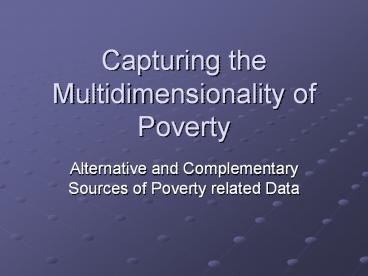Capturing the Multidimensionality of Poverty - PowerPoint PPT Presentation
Title:
Capturing the Multidimensionality of Poverty
Description:
Title: Slide 1 Author: unsd Last modified by: unsd Created Date: 6/29/2005 9:24:02 PM Document presentation format: On-screen Show Company: un Other titles – PowerPoint PPT presentation
Number of Views:24
Avg rating:3.0/5.0
Title: Capturing the Multidimensionality of Poverty
1
Capturing the Multidimensionality of Poverty
- Alternative and Complementary Sources of Poverty
related Data
2
The MDG Imperative
- The MDGs, in focusing on the multiple dimensions
of development, emphasize the need to draw on a
wide range of data sources to reveal different
facets of poverty and to cross-check on findings - These sources can generate information on the
tangible and non-tangible aspects of living
levels and the strength and importance of various
sentiments and conditions
3
Coverage of Items
Material Non-Material
Market Household goods sold at full prices Services sold insurance, transport,etc
Non-Market Not sold Collective public goods Final household consumption of gov gs Own farm production Emergency supplies Rations, Informal midwives, etc Security, street lighting Health housing education
4
Aspects
- Issues above ignore questions of access and
exclusion and role of civil society - In handling questions of who, how many, how
much, where found and what people do who are
poor, we need to know at least the - Extent
- Incidence
- Severity
- Location
- Characteristics of poverty
5
Types of Data Sources
- Censuses and sample censuses population,
housing, agriculture, etc - Ministerial Records
- Civil registration
- Official commissions of Enquiry
- Community Level Studies by NGOs
- Qualitative Surveys
6
Non Formal Approaches
- Key informants
- Focus groups
- Interpreters and independent observers
- Opinion surveys
- Market surveys
- Sensory studies
- Rapid rural appraisals
- Social weather stations perceptions and their
strength - Self assessments
- Miscellaneous indicators
7
Mapping
- The CWIQ as a filter and CWIQ Plus
- LSMS Community Surveys
- SDA priority surveys
- Triangulation attenuation? techniques
- The use of qualitative methods to probe in
depth, to identify issues and signal concerns
reducing non-sampling error, improving
stratification criteria.































